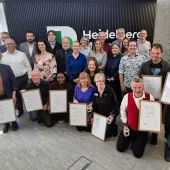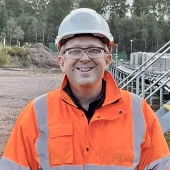Buying-in to Biodiversity

First published in the May 2020 issue of Quarry Management
Sean Cassidy, regional environment manager at CEMEX, highlights the importance of dedicated conservation and biodiversity strategies for quarries
As quarry operators, the misplaced assumption from those outside of the sector can be that we simply extract what we need from the environment, rather than actively considering our impact and seeking to improve the habitat and biodiversity of the areas in which we work.
However, biodiversity and habitat loss is a serious issue that affects us all. As such, all of us in the industry must closely examine our operations and implement comprehensive biodiversity and conservation strategies to ensure our natural world can be enjoyed by future generations.
At CEMEX, we recognize and embrace our responsible use of resources and encourage a proactive attitude to biodiversity conservation and restoration. We believe that by prioritizing sustainability and setting specific targets and objectives, we ensure that our business can continue to work towards our vision of building a better future.
In particular, we aim to align our biodiversity initiatives with our business model so that the identification, assessment and management of biodiversity values is considered in our decision-making process and management systems, throughout the life cycle of our sites. This work is guided by our Corporate Biodiversity Policy (part of a wider sustainability strategy) which is aligned with the Aichi Biodiversity Targets from the Convention on Biological Diversity. In addition, our work is aligned with the UN SDGs and in particular ‘Ecosystem Conservation’ (15), which has been identified as one of CEMEX’s five key SDGs.
At CEMEX, we believe that the importance of conservation and biodiversity must be understood and prioritized at a top, strategic level of the company for it to achieve the most success and the most positive impact.
Fortunately, we see a similar sense of responsibility mirrored in other operators throughout the industry and we believe that most appreciate the fact that restored quarries are excellent for biodiversity. This has certainly been helped by initiatives such as the Mineral Product Association’s Biodiversity Awards, which do not just reward good restoration but also innovative ideas, planned restorations and collaboration with non-governmental organizations (NGOs). This element of competition encourages operators to want to improve biodiversity projects at quarries, and in turn this has helped to raise standards across the industry. There has also been increasing pressure from mineral planning authorities to see improvements to habitat in order to support wildlife, which means all quarry operators are aware of the need to focus on this issue.
As a result, the majority of quarry operators in the UK now have biodiversity policies and management systems in place, to help create either Biodiversity Action Plans (BAPs) or Biodiversity Management Plans. There is certainly a need for operators to prioritize this quickly if they have not already done so, as the MPA target is for all operational quarries to have a BAP in place by 2025.
At CEMEX, we now have BAPs in place at sites to enhance biodiversity in and around our quarries located in or close to high biodiversity value areas, whilst starting new BAP projects at all other quarries. They incorporate varied actions that improve ecosystem services and create space for rewilding, presenting opportunities for working alongside NGOs to develop species-rich habitats. These BAPs help drive good management and deliver planning wins for nature conservation, local communities and the business.
For those operators who need support with enhancing the biodiversity at their quarries, relationships with wildlife charities and NGOs can prove invaluable. A key aspect of our success has been our partnership with the RSPB, which has now been in place for just over 10 years. We decided to partner with the RSPB in 2009 because they are one of Europe’s largest NGOs with huge conservation knowledge, experience and expertise, and they had the scale and willingness to work with us.
This relationship is critical for us to deliver ongoing net gain in biodiversity across our active quarry sites so when we complete our work, we are giving more back to society and the environment than was there to start with. When we started working with the RSPB we made a commitment to create 100ha a year to give nature a home. This amount was exceeded with 1,000ha achieved three years earlier than targeted.
Not only does the RSPB work with us on our UK strategy for biodiversity and conservation, but it also helps during the planning stage and on the ground at sites, so all quarry managers can contact a dedicated business conservation advisor if they have any questions or ideas.
Getting buy-in from those who are based at the quarry itself is also key to ensuring success; quarry managers can be self-motivated and want to do something for biodiversity using their own initiative. For instance, at our one of our sites an operator took it upon himself to start creating a wildlife area within the quarry. His enthusiasm was so infectious he ended up getting everyone involved; including senior managers.
Having the BAP process and prioritizing biodiversity lends itself to this sort of project – the results at this quarry have been impressive, including creating nesting areas for the red-listed (of conservation concern) common and little ringed plover. Having a management structure that encourages this is very important as it gives the local team the information they need to understand the local habitats, and then they can go on to prioritize which species to protect and encourage.
Additionally, if the quarry manager or biodiversity manager can encourage stakeholder engagement and get input from local residents or local NGOs, this can have a substantial beneficial effect. We have seen for ourselves that this produces real benefits – in addition to our partnership with the RSPB, Butterfly Conservation has helped at several of our sites and it has encouraged quarry management to engage with the biodiversity agenda much more effectively; because they can see the bigger picture.
We have also had nationally recognized success with Nottingham Wildlife Trust at Attenborough and the local RSPB at Denge. Later this year (coronavirus pandemic permitting) a Quarrywatch Day is planned at Denge, held jointly with the RSPB and MPA. At this event, local politicians, NGOs and stakeholders will get a hands-on experience trying to spot some of the UK’s rarest species during a ‘Bio Blitz’.
However, this is not to say there is not still more than can be done. It is important to remember that biodiversity and conservation work at quarries is not just about protecting wildlife species, restoring sites to priority habitat or creating wildlife areas; in urban areas this can also improve air quality, water quality and give locals somewhere to walk or relax, so it has a social impact as well. Most importantly, and crucial given our own carbon footprint, natural habitats are very important for sequestering and storing greenhouse gases, most notably CO2.
As an industry, we must continue to prioritize this area of our operation, despite other pressures. The results we achieve can have a wide-ranging impact on our local communities and the world at large, whilst also having a real effect on our licence to operate.
- Subscribe to Quarry Management, the monthly journal for the mineral products industry, to read articles before they appear on Agg-Net.com








